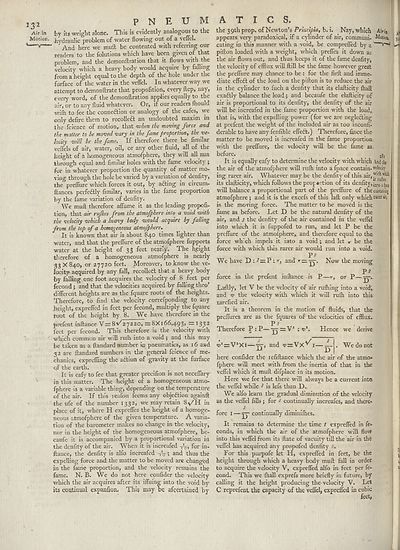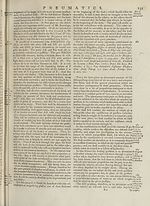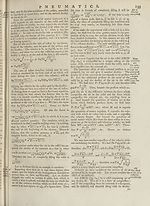Encyclopaedia Britannica > Volume 15, PLA-RAM
(148) Page 132
Download files
Complete book:
Individual page:
Thumbnail gallery: Grid view | List view

332 P N E U M
Air in foy Jts weight alone. This is evidently analogous to the
Mot:°n- hydraulic problem of water flowing out of a veffel.
And here we muft be contented with referring our
readers to the folutions which have been given of that
problem, and the demonilration that it flows with the
velocity which a heavy body would acquire by falling
from a height equal to the depth of the hole under the
furface of the water in the veflel. In whatever way we
attempt to demon Urate that propofition, every ilep, nay,
every word, of the demonftration applies equally to the
air, or to any fluid whatever. Or, if our readers (hould
vrifh to fee the connexion or analogy of the cafes, we
only defire them to recolleft an undoubted maxim in
the fcience of motion, that •when the moving force and
the matter to be moved vary in the fame proportion, the ve¬
locity luiil be the fame. If therefore there be fimilar
veflels of air, water, oil, or any other fluid, all of the
height of a homogeneous atmofphere, they will all nun
through equal and fimilar holes with the fame velocity ;
for in whatever proportion the quantity of matter mo¬
ving through the hole be varied by a variation of denflty,
the preflure which forces it out, by adding in circum-
ftances perfectly fimilar, varies in the fame proportion
by the fame variation of denfity.
We muft therefore affume it as the leading propofi¬
tion, that air ritjhes from the atmofphere into a void •with
the velocity which a heavy body would acquire by falling
from the top of a homogeneous atmofphere.
It is known that air is about 840 times lighter than
water, and that the preflure of the atmofphere fupports
water at the height of 33 feet nearly. The height
therefore of a homogeneous atmofphere is nearly
33 X 840, or 27720 feet. Moreover, to know the ve¬
locity acquired by any fall, recollett that a heavy body
by falling one foot acquires the velocity of 8 feet per
fecond ; and that the velocities acquired by falling thro’
different heights are as the fquare roots of the heights.
Therefore, to find the velocity correfponding to any
height, expreficd in feet per fecond, multiply the fquare
root of the height by 8. We have therefore in the
prefent inftance 27220, = 8X166,493, =: 1332
feet per fecond. This therefore is the velocity with
which common air will rufti into a void ; and this may
be taken as a ftandard number in pneumatics, as 16 asd
32 are ftandard numbers in the general fcience of me¬
chanics, exprefling the a&ion of gravity at the furface
of the earth.
It is eafy to fee that greater precifion is not neceffary
in this matter. The height of a homogeneous atmo¬
fphere is a variable thing, depending on the temperature
of the air. If this reafon feems any objeftion againft
the ufe of the number 1332, we may retain 8v/H in
place of it, where H exprefles the height of a homoge¬
neous atmofphere of the given temperature. A varia¬
tion of the barometer makes no change in the velocity,
nor in the height of the homogeneous atmofphere, be-
caufe it is accompanied by a proportional variation in
the denfity of the air. When it is increafed for in¬
ftance, the denfity is alfo increafed Yo » and thus the
expelling force and the matter to be moved are changed
in the fame proportion, and the velocity remains the
fame. N. B. We do not here confider the velocity
which the air acquires after its ifluing into the void by
its continual expanfion. This may be aftertained by
a t 1 c s.
the 39th prop, of Newton’s Princtpla, b. i. Nay, which Air in
appears very paradoxical, if a cylinder of air, communi- Motion
eating in this manner with a void, be comprefled by a
pifton loaded with a weight, which prefles it down as
the air flows out, and thus keeps it of the fame denfity,
the velocity of efflux will ftill be the fame however great
the preflure may chance to be : for the firft and imme¬
diate effeft of the load on the pifton is to reduce the air
in the cylinder to fuch a denlity that its elafticity ffiall
exaftly balance the load; and becaufe the elafticity of
air is proportional to its denfity, the denfity of the air
will be increafed in the fame proportion with the load,
that is, with the expelling power (for we are neglecting
at prefent the weight of the included air as too inconfi-
derable to have any fenfible effeCt.) Therefore, fince the
matter to be moved is increafed in the fame proportion
with the preflure, the velocity will be the fame as
before. / ... 2!?
It is equally eafy to determine the velocity with which And the
the air of the atmofphere will rufh into a fpace contain-velocity
ing rarer air. Whatever may be the denfity of this air,
its elafticity, which follows the proportion of its denfity,in,oa^a;!
will balance a proportional part of the preflure of the containing
atmofphere ; and it is the excefs of this laft only which rater ^1
is the moving force. The matter to be moved is the
fame as before. Let D be the natural denfity of the
air, and s the denfity of die air contained in the veflel
into wliich it is fuppofed to run, and let P be the
preflure of the atmofphere, and therefore equal to the
force which impels it into a void; and let r be the
force with which this rarer air would run into a void.
PS
We have D : ^=:P: and Now the moving
P^
force in the prefent inftance is P—r, or P—jy.
Laftly, let V be the velocity of air ruffling into a void,
and v the velocity with which it will ruffi into this
rarefied air..
It is a theorem in the motion of fluids, that the
prefliires are as- the fquares of the velocities of efflux.
P r
Therefore P:P—-jj =:V* : a>*. Hence we derive
dcrV^l-
D
and vzzVX
We do not
here confider the lefiftance which the air of the atmo*
fphere will meet with from the inertia of that in the
veflel which it muft difplace in its motion.
Here we fee that there will always be a current into
the veffel while $ is lefs than D.
We alfo learn the gradual diminution of the velocity
as the veflel fills j for <*' continually increafes, and there-*
s
fore I — jy continually diminiflies.
It remains to determine die time t exprefled in fe-
conds, in which the air of the atmofphere will flow
into this veflel from its ftate of vacuity till the air in the
veflel has acquired any propofed denfity
For this purpofe let H, exprefled in feet, be the
height through which a heavy body muft fall in order
to acquire the velocity V, exprefled alfo in feet per fe¬
cond. This we fliall exprefs more briefly in future, by
calling it the height producing the velocity V. Let
C reprefent the capacity of the veflel, exprefled in cubic
Air in foy Jts weight alone. This is evidently analogous to the
Mot:°n- hydraulic problem of water flowing out of a veffel.
And here we muft be contented with referring our
readers to the folutions which have been given of that
problem, and the demonilration that it flows with the
velocity which a heavy body would acquire by falling
from a height equal to the depth of the hole under the
furface of the water in the veflel. In whatever way we
attempt to demon Urate that propofition, every ilep, nay,
every word, of the demonftration applies equally to the
air, or to any fluid whatever. Or, if our readers (hould
vrifh to fee the connexion or analogy of the cafes, we
only defire them to recolleft an undoubted maxim in
the fcience of motion, that •when the moving force and
the matter to be moved vary in the fame proportion, the ve¬
locity luiil be the fame. If therefore there be fimilar
veflels of air, water, oil, or any other fluid, all of the
height of a homogeneous atmofphere, they will all nun
through equal and fimilar holes with the fame velocity ;
for in whatever proportion the quantity of matter mo¬
ving through the hole be varied by a variation of denflty,
the preflure which forces it out, by adding in circum-
ftances perfectly fimilar, varies in the fame proportion
by the fame variation of denfity.
We muft therefore affume it as the leading propofi¬
tion, that air ritjhes from the atmofphere into a void •with
the velocity which a heavy body would acquire by falling
from the top of a homogeneous atmofphere.
It is known that air is about 840 times lighter than
water, and that the preflure of the atmofphere fupports
water at the height of 33 feet nearly. The height
therefore of a homogeneous atmofphere is nearly
33 X 840, or 27720 feet. Moreover, to know the ve¬
locity acquired by any fall, recollett that a heavy body
by falling one foot acquires the velocity of 8 feet per
fecond ; and that the velocities acquired by falling thro’
different heights are as the fquare roots of the heights.
Therefore, to find the velocity correfponding to any
height, expreficd in feet per fecond, multiply the fquare
root of the height by 8. We have therefore in the
prefent inftance 27220, = 8X166,493, =: 1332
feet per fecond. This therefore is the velocity with
which common air will rufti into a void ; and this may
be taken as a ftandard number in pneumatics, as 16 asd
32 are ftandard numbers in the general fcience of me¬
chanics, exprefling the a&ion of gravity at the furface
of the earth.
It is eafy to fee that greater precifion is not neceffary
in this matter. The height of a homogeneous atmo¬
fphere is a variable thing, depending on the temperature
of the air. If this reafon feems any objeftion againft
the ufe of the number 1332, we may retain 8v/H in
place of it, where H exprefles the height of a homoge¬
neous atmofphere of the given temperature. A varia¬
tion of the barometer makes no change in the velocity,
nor in the height of the homogeneous atmofphere, be-
caufe it is accompanied by a proportional variation in
the denfity of the air. When it is increafed for in¬
ftance, the denfity is alfo increafed Yo » and thus the
expelling force and the matter to be moved are changed
in the fame proportion, and the velocity remains the
fame. N. B. We do not here confider the velocity
which the air acquires after its ifluing into the void by
its continual expanfion. This may be aftertained by
a t 1 c s.
the 39th prop, of Newton’s Princtpla, b. i. Nay, which Air in
appears very paradoxical, if a cylinder of air, communi- Motion
eating in this manner with a void, be comprefled by a
pifton loaded with a weight, which prefles it down as
the air flows out, and thus keeps it of the fame denfity,
the velocity of efflux will ftill be the fame however great
the preflure may chance to be : for the firft and imme¬
diate effeft of the load on the pifton is to reduce the air
in the cylinder to fuch a denlity that its elafticity ffiall
exaftly balance the load; and becaufe the elafticity of
air is proportional to its denfity, the denfity of the air
will be increafed in the fame proportion with the load,
that is, with the expelling power (for we are neglecting
at prefent the weight of the included air as too inconfi-
derable to have any fenfible effeCt.) Therefore, fince the
matter to be moved is increafed in the fame proportion
with the preflure, the velocity will be the fame as
before. / ... 2!?
It is equally eafy to determine the velocity with which And the
the air of the atmofphere will rufh into a fpace contain-velocity
ing rarer air. Whatever may be the denfity of this air,
its elafticity, which follows the proportion of its denfity,in,oa^a;!
will balance a proportional part of the preflure of the containing
atmofphere ; and it is the excefs of this laft only which rater ^1
is the moving force. The matter to be moved is the
fame as before. Let D be the natural denfity of the
air, and s the denfity of die air contained in the veflel
into wliich it is fuppofed to run, and let P be the
preflure of the atmofphere, and therefore equal to the
force which impels it into a void; and let r be the
force with which this rarer air would run into a void.
PS
We have D : ^=:P: and Now the moving
P^
force in the prefent inftance is P—r, or P—jy.
Laftly, let V be the velocity of air ruffling into a void,
and v the velocity with which it will ruffi into this
rarefied air..
It is a theorem in the motion of fluids, that the
prefliires are as- the fquares of the velocities of efflux.
P r
Therefore P:P—-jj =:V* : a>*. Hence we derive
dcrV^l-
D
and vzzVX
We do not
here confider the lefiftance which the air of the atmo*
fphere will meet with from the inertia of that in the
veflel which it muft difplace in its motion.
Here we fee that there will always be a current into
the veffel while $ is lefs than D.
We alfo learn the gradual diminution of the velocity
as the veflel fills j for <*' continually increafes, and there-*
s
fore I — jy continually diminiflies.
It remains to determine die time t exprefled in fe-
conds, in which the air of the atmofphere will flow
into this veflel from its ftate of vacuity till the air in the
veflel has acquired any propofed denfity
For this purpofe let H, exprefled in feet, be the
height through which a heavy body muft fall in order
to acquire the velocity V, exprefled alfo in feet per fe¬
cond. This we fliall exprefs more briefly in future, by
calling it the height producing the velocity V. Let
C reprefent the capacity of the veflel, exprefled in cubic
Set display mode to:
![]() Universal Viewer |
Universal Viewer | ![]() Mirador |
Large image | Transcription
Mirador |
Large image | Transcription
Images and transcriptions on this page, including medium image downloads, may be used under the Creative Commons Attribution 4.0 International Licence unless otherwise stated. ![]()
| Encyclopaedia Britannica > Encyclopaedia Britannica > Volume 15, PLA-RAM > (148) Page 132 |
|---|
| Permanent URL | https://digital.nls.uk/191902700 |
|---|
| Attribution and copyright: |
|
|---|
| Description | Ten editions of 'Encyclopaedia Britannica', issued from 1768-1903, in 231 volumes. Originally issued in 100 weekly parts (3 volumes) between 1768 and 1771 by publishers: Colin Macfarquhar and Andrew Bell (Edinburgh); editor: William Smellie: engraver: Andrew Bell. Expanded editions in the 19th century featured more volumes and contributions from leading experts in their fields. Managed and published in Edinburgh up to the 9th edition (25 volumes, from 1875-1889); the 10th edition (1902-1903) re-issued the 9th edition, with 11 supplementary volumes. |
|---|---|
| Additional NLS resources: |
|

